Diversity and Inclusion on our Training Programme 2020/21
A snapshot report summarising current key diversity statistics for our Training Programme.
Fairness is at the heart of what we do at Teach First. We believe everyone deserves equal opportunity to access a good education – that’s true of our pupils, but also the teachers and leaders we train.
We’re committed to transparently monitoring diversity and inclusion across our recruitment processes and the programmes we run. We want to ensure no one is disadvantaged because of their ethnicity, gender, sexuality, or background.
This is a starting point: a snapshot report summarising current key diversity statistics for our Training Programme. We commit to publishing bi-annual reports that cover all our teacher development and leadership programmes. This will help us – and you – identify how we’re doing, where we’re falling short, and how we can improve.
Our commitment is for our teachers to be representative of the pupils in the communities we serve. We believe it is important for pupils in partner schools to have access to teachers and leaders from all backgrounds. We therefore strive to recruit candidates from diverse backgrounds and support them to thrive on our programmes from starting off as a trainee teacher to becoming a headteacher in a school serving disadvantaged communities.
Who are our trainees?
Below are the characteristics of Training Programme ambassadors in comparison to current trainees and our incoming cohort.
Characteristics of Training Programme ambassadors in comparison to current trainees and incoming cohort
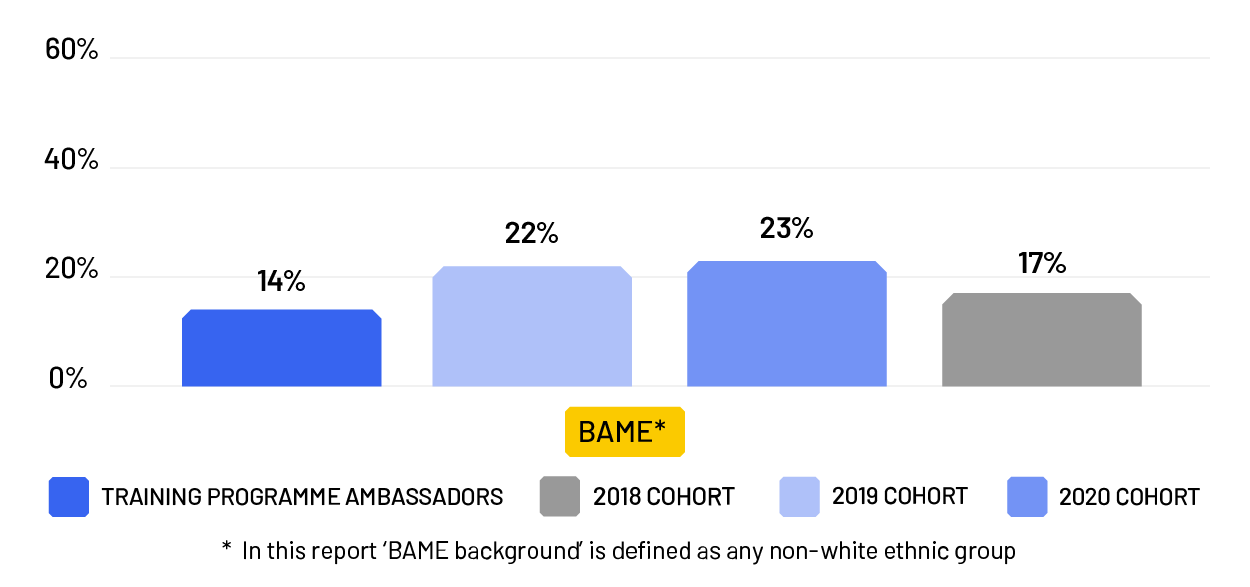
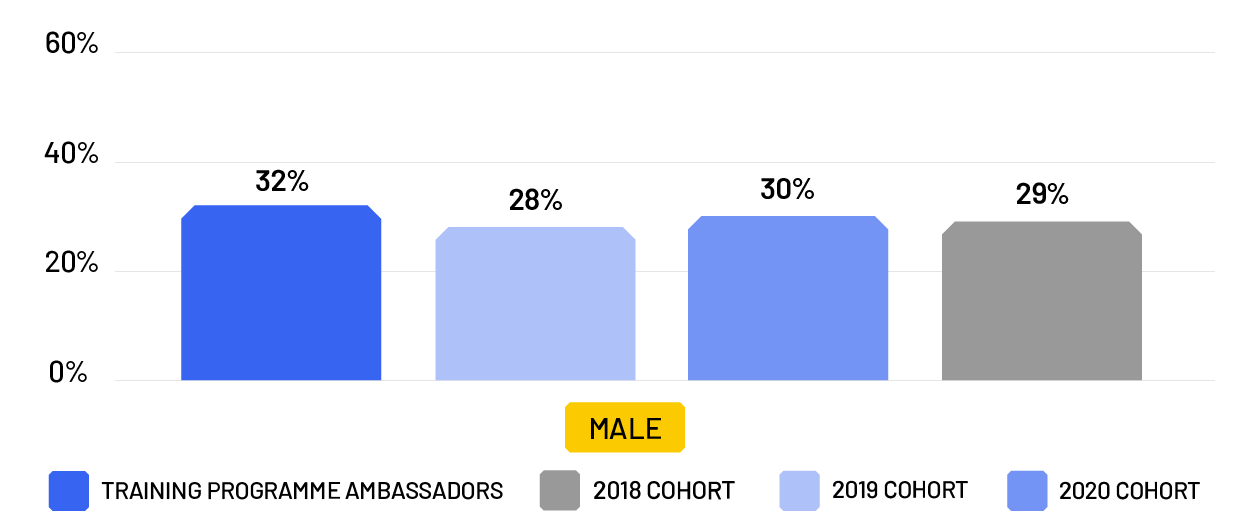
This shows that trainees on the programme have become more diverse over time, with almost a quarter (23%) of our 2020 cohort coming from a BAME background.
But to get an even greater scope of diversity in this cohort, we also compared their characteristics to pupils in our partner schools and the national teaching workforce.
Characteristics of trainees, compared to pupils and national teaching workforce
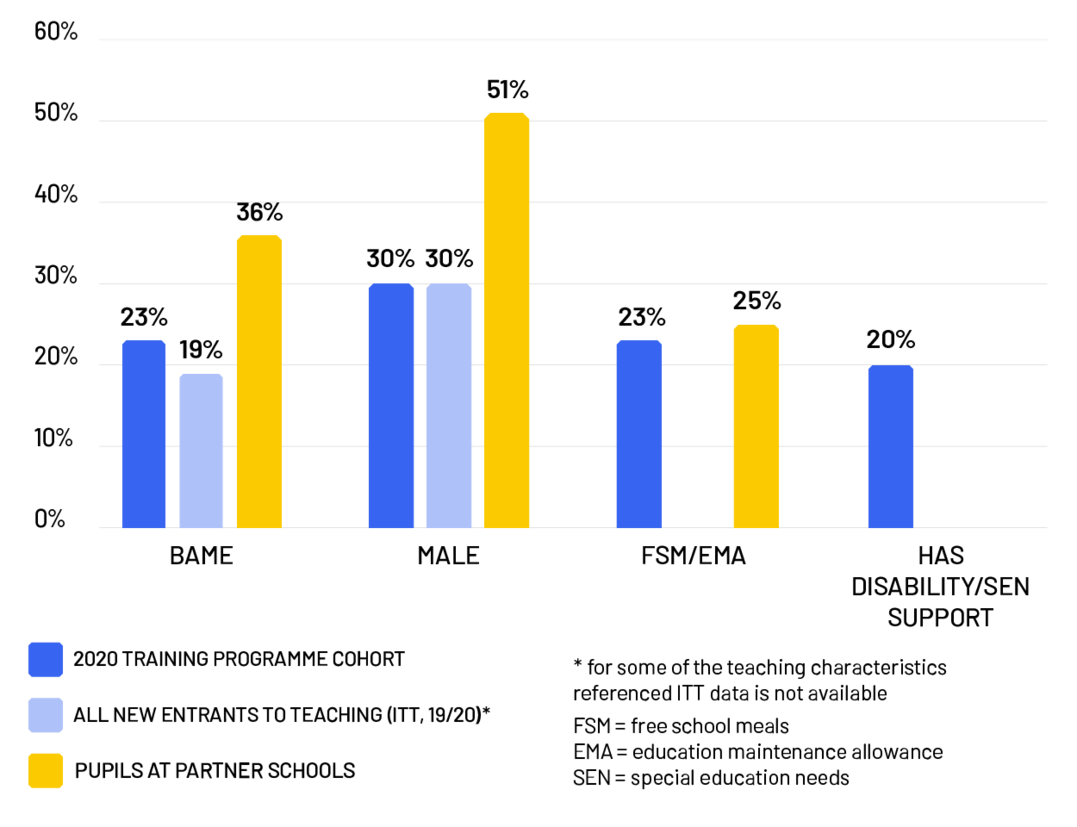
23% of our new trainees in 2020 are from an ethnic minority background. Whilst this is higher than that of teaching as a whole, it’s still not reflective of the percentage of BAME pupils in our partner schools – who make up over a third (36%) of students in those schools.
12% of ambassadors still teaching were from an ethnic minority background compared to 10.5% of the teaching workforce as a whole (DfE 2019) and 14% of the general population (Census 2011). It is our goal to ensure that the characteristics of our cohort more fully reflect the characteristics of the communities we serve.
And while 30% of trainees in the 2020 cohort are male, which is the same as we see nationally, men are still underrepresented in the profession.
And 20% of our 2020 Training Programme cohort has disclosed some form of disability. According to government statistics, 16% of working age adults are living with a disability.
Who are we recruiting?
When it comes to recruiting trainees, how likely applicants are to be successful can vary based on a wide range of different factors.
Overall application success rate based on ethnic grouping (%)
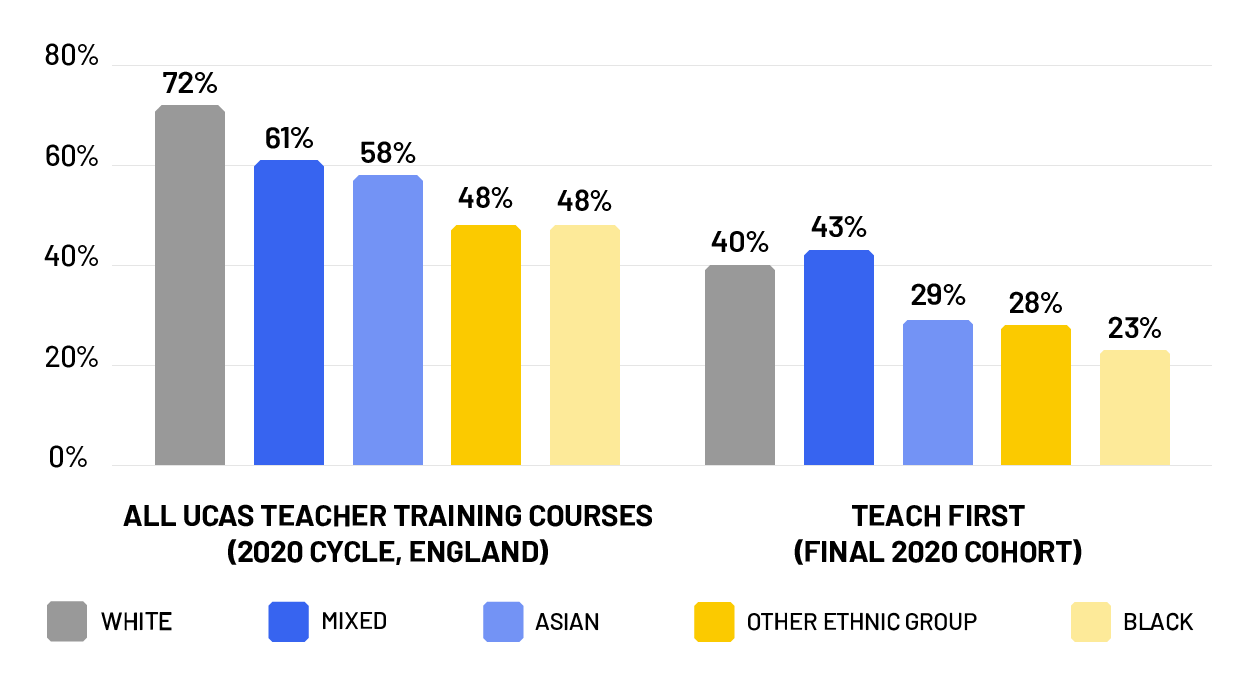
Across all initial teacher training courses, applicants from a white background had a higher success rate than those from minority ethnic groups. But in our 2020 Training Programme cohort, those from a mixed-race ethnic background had the highest application success rate.
We’re taking steps to better understand and address why we’re seeing this discrepancy in our application process, including analysis to explore other factors that may influence application outcomes and how they relate to demographic characteristics.
In-programme retention of trainees (2020 cohort) (YTD Jan 2021)
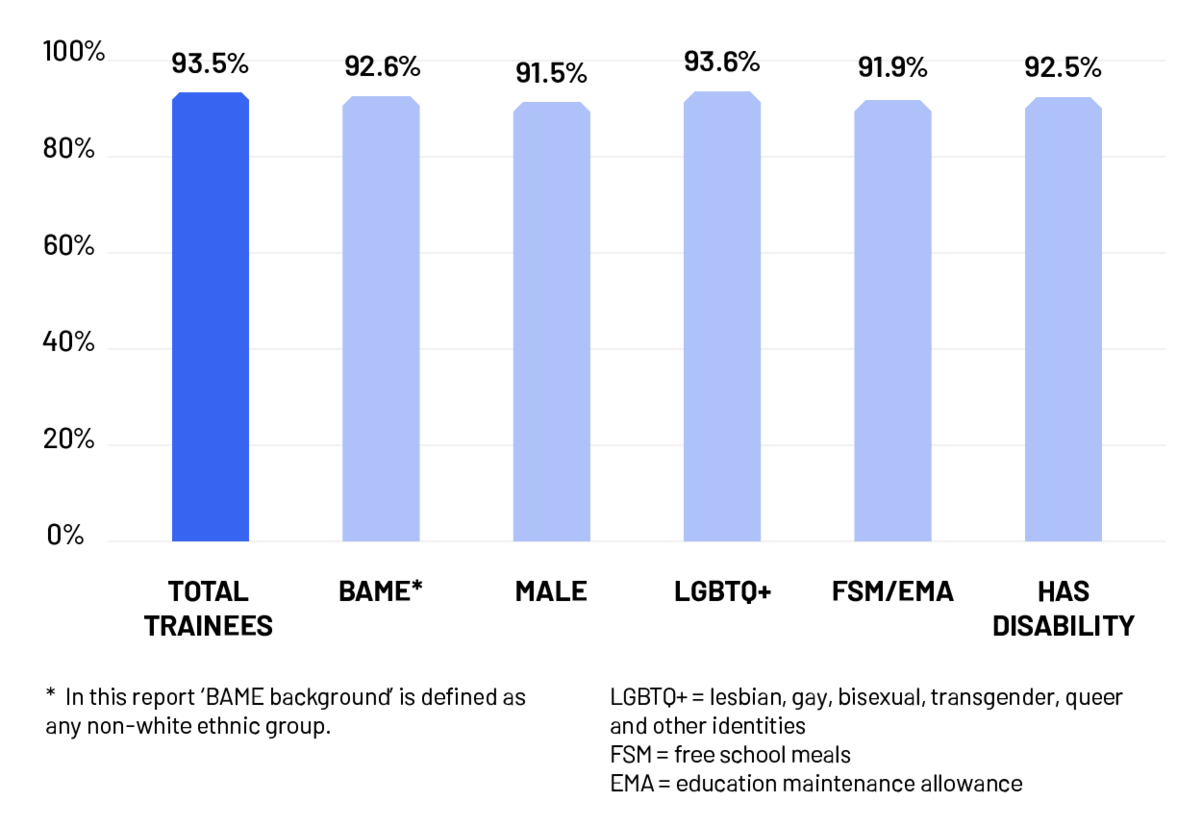
Once on the programme, we found there to be no significant difference in the retention of trainees according to their background.
Who completed the Training Programme?
These are the characteristics of Training Programme ambassadors currently teaching:
Percentage of Training Programme ambassadors currently teaching
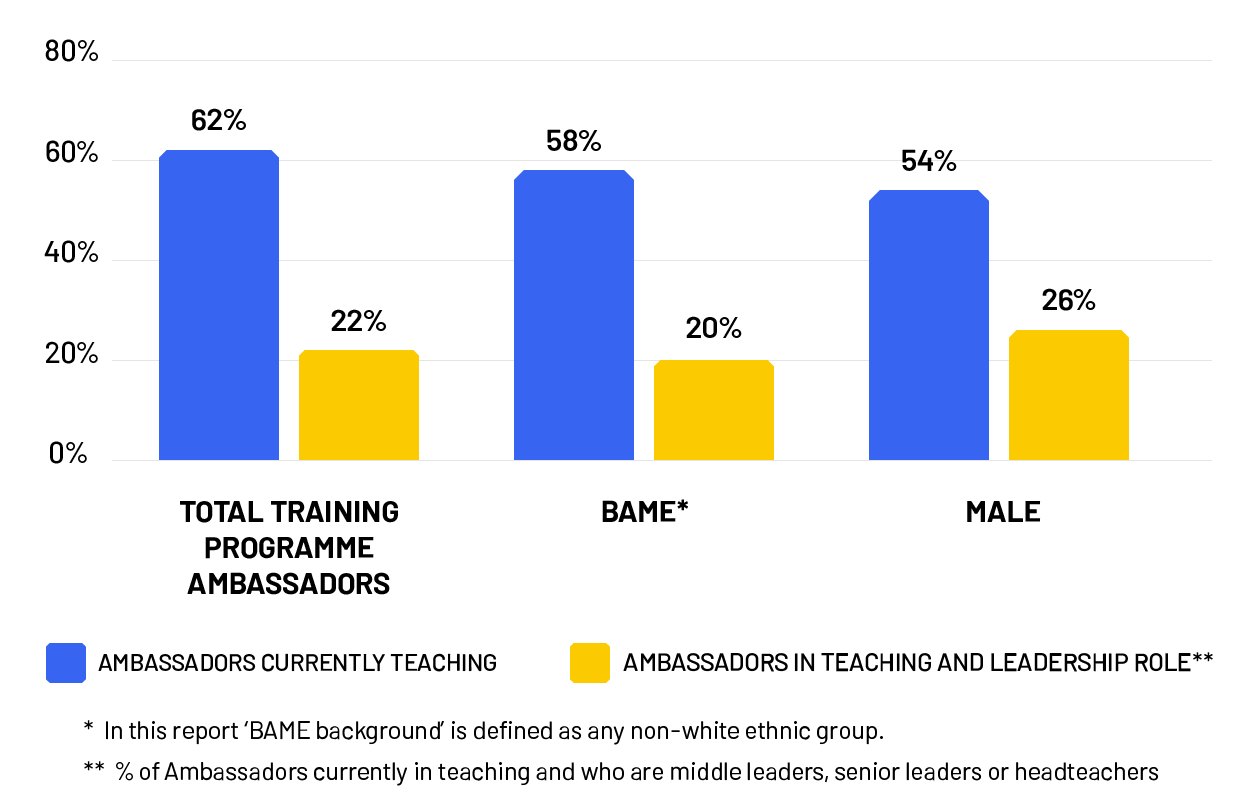
We found males less likely to remain in teaching. But if they are still in teaching, they’re more likely to be in a leadership role.
Ambassadors from ethnic minority backgrounds are also less likely to remain in teaching. This is based on the teaching status of all ambassadors and the time that has passed since they finished the programme will vary.
The progression and retention of ambassadors after the programme is affected by a range of forces in the system. We are planning ways we can play a greater role in the fair progression of ambassadors (and their colleagues) into leadership roles and contribute to the wider debate around the design of the system itself.
Next steps
We will continue to monitor diversity and inclusion on the Training Programme, and we’ll produce similar analysis across all our teacher development and leadership programmes regularly.
We want to understand why we might be seeing certain trends to help inform the actions we need to take. To do this, we’ll carry out more sophisticated analysis that can identify how a person’s characteristics might affect their outcomes.
As we seek to get better insights, we will continue with initiatives to improve diversity and inclusion in our programmes and across the wider sector:
- Increasing representation from underrepresented backgrounds on our teacher development and leadership programmes with targeted support for aspiring leaders from underrepresented backgrounds.
- Improving our systems for reporting, tracking and dealing with D&I incidents.
- Equipping programme members to take action to improve diversity and inclusion in their schools and wider communities through programme content and support.
- Supporting ambassador affinity networks.
- Advocating for greater diversity in the curriculum.
We’ll also continue to identify ways that we can be more transparent with our data and what it tells us about our impact.
Find out more about our work on the Diversity and Inclusion hub.
